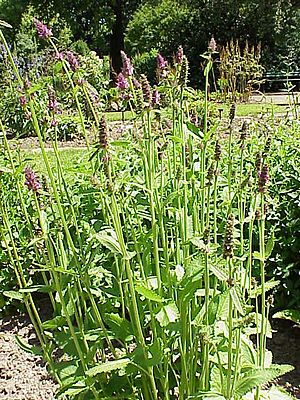Crosne facts for kids
Quick facts for kids Crosne |
|
|---|---|
 |
|
| Scientific classification | |
| Genus: |
Stachys
|
| Species: |
affinis
|
| Synonyms | |
|
|
Stachys affinis, often called crosne, Chinese artichoke, or Japanese artichoke, is a special plant from China. It's a perennial herbaceous plant, meaning it lives for more than two years and has soft, green stems instead of woody ones. It belongs to the Lamiaceae family, which also includes mint! The part of the plant we eat is its rhizome, which is like an underground stem. These rhizomes grow into small, bumpy tubers that look a bit like tiny white caterpillars. You can eat them raw, pickled, dried, or cooked.
Contents
What is Crosne?
Crosne is a plant that can grow from about 30 to 120 centimeters tall. It has green leaves that grow opposite each other on the stem. These leaves can be shaped like a heart (ovate-cordate) or more oval (ovate-oblong). They feel a bit rough, like a nettle. Each leaf has a blade and a small stalk called a petiole that connects it to the stem.
Just like potatoes, crosne grows special underground stems called rhizomes. These rhizomes are about 8 cm long and 2 cm thick. They get thicker in certain spots, forming bumpy, white tubers. These tubers are usually thinner at both ends and are covered with a thin, pale-beige or ivory-colored skin. Inside, the flesh is white and tender.
What's Inside Crosne?
The tubers of crosne are full of a special sugar called stachyose. This sugar is made up of other sugars like galactose, glucose, and fructose. Stachyose makes up a big part of the dry weight of the tubers, sometimes as much as 80-90%!
Where Does Crosne Come From?
Crosne originally comes from central and northern China. People in China have been growing and eating it since at least the 13th century.
Before crosne came to Europe, people there used to gather a similar plant called Stachys palustris from nature to eat. Later, people in Germanic regions used another relative, Stachys recta, as a medicinal plant. Crosne itself was first grown on a farm in Europe in 1882, in a place called Crosne in France. This is where it got its common name!
At the start of the 20th century, crosne became very popular. But then, in the 1970s, its popularity dropped because of problems with plant viruses and because the plant spread very easily. However, since the 1990s, people have started growing crosne more often again. You can now find it in some markets and grocery stores. Today, it's even listed as an "invasive plant" in Europe, meaning it can spread quickly and take over areas if not managed.
How Crosne is Classified
Crosne is part of the plant family called Lamiaceae. Another species, S. sieboldii, was described later but is now considered to be the same plant as S. affinis.
Growing Crosne
You plant crosne tubers in the spring, usually between March and May. You should plant several tubers about 5 to 8 cm deep in a hole that's about 30 by 30 cm. The plant can grow up to 30 cm tall. It's important to remove weeds around the plants, but be careful not to hurt the roots. Crosne also needs enough water during the summer.
You can harvest crosne from November to March. The most important thing is that the soil isn't frozen when you try to dig them up!
Storing crosne tubers can be a bit tricky. Because their skin is so thin, they only stay fresh for a few days in the fridge, maybe about a week. A better way to keep them fresh for several months is to store them in moist sand and harvest them as you need them.
How We Use Crosne
In the Kitchen
Crosne tubers have a crunchy texture and a sweet, nutty taste. You can eat them in many ways: raw, pickled, dried, or cooked. They are used in dishes in many countries. You can prepare them in a similar way to Jerusalem artichokes. Even the leaves can be dried and made into a tea!
In Chinese and Japanese cuisine, crosne is often pickled. In Japan, the pickled tubers are a special part of Osechi, which is a meal eaten to celebrate Japanese New Year. When they are dyed red using leaves from the Perilla plant (red shiso), they are called chorogi. In Korea, they are known as choseokjam (초석잠).
In French cuisine, cooked crosne tubers are often served with dishes that are called japonaise or "Japanese-style."
For Health
In traditional Chinese medicine, the whole crosne plant is used to help treat things like colds and pneumonia.
Scientists have also found that extracts from crosne roots can help fight against tiny germs (this is called antimicrobial activity). Studies have also shown that crosne has antioxidant activity, which means it can help protect your body's cells from damage. Some research even suggests that extracts from crosne might have antitumour activity, meaning they could help fight against certain types of growths.
See also
 In Spanish: Stachys affinis para niños
In Spanish: Stachys affinis para niños


